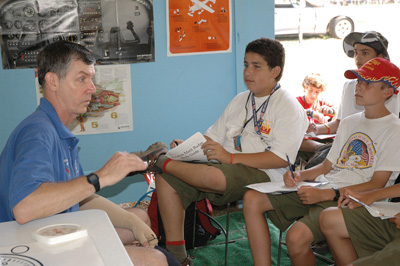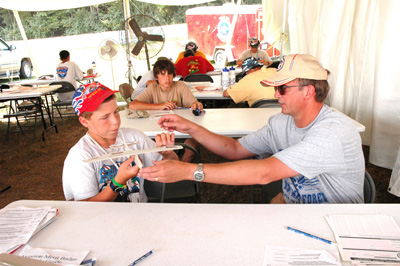Better than aviation education is a really cool patch
By Staff Sgt. C. Todd Lopez
FORT A.P. HILL, Va. (Aug. 05, 2005) -- About 43,000 Boy Scouts departed this Army installation Aug. 3 after 10 days of scouting, camping and learning.
As part of the 2005 National Scout Jamboree, Boy Scouts nationwide gathered to make new friends, practice their scouting skills and earn "merit badges."

Thanks to retired Lt. Col. Tom Sawner, a former pilot, about 1,000 of those young men left the Jamboree with a new merit badge and a greater appreciation and understanding of aviation.
The aviation merit badge is particularly difficult to get, Colonel Sawner said, because the resources needed to complete the requirements for the badge are not often available to Scouts at home. But at the Jamboree, Scout leaders have worked hard to make those resources available to the young men who want to earn this unique patch.
"Where else could you pull together as many Air Force pilots as you can here?" Colonel Sawner asked. "Back home, maybe (a Boy Scout troop) has access to one. Here we have about 20."
To earn the aviation merit badge, Scouts are required to sit through a two-hour course to learn the basics of aviation, conduct interviews with pilots and certified flight instructors and demonstrate their knowledge of flight by pointing out and explaining the parts of an aircraft. They also write several reports on what they have learned, and take a short test to verify their knowledge.
"It was definitely a challenge to figure out and remember and get to know all these things," said Scout Josh Curry of Boy Scout Troop 106, near Warren, Maine. "I basically knew nothing about aviation when I came here. I knew how airplanes were run, but I knew none of the terms which I know now."
Colonel Sawner was a Boy Scout himself, and earned his aviation merit badge when he was 13 years old. He is a 1976 graduate of the Air Force Academy and his first assignment was as an F-4 Phantom pilot. He retired from active duty service in 1999, but has been helping Boy Scouts learn about aviation for 20 years -- attending his first Scout Jamboree as an educator in 1985.
At the aviation merit badge tent on the "Merit Badge Midway" here, Colonel Sawner led a contingent of aviation educators including retired and active-duty Air Force fighter and tanker pilots, civilian pilots, certified flight instructors and one Navy pilot. Together, they helped Scouts learn about what keeps an aircraft in the air, while keeping the learning environment exciting.

"They like hearing fighter pilot stories," Colonel Sawner said. "It keeps them awake in the class."
Josh said working with the pilots was both educational and fun.
"Interacting with the Air Force people was a lot of fun because they taught me how all the engines worked, what all the parts were, the burners, where the fuel comes in and about each kind of engine," he said after earning his aviation badge. "I learned a lot about different airplanes and it was a lot of fun."
The Scouts who completed all the requirements are authorized to wear the aviation merit badge on their badge sash at special Boy Scout events. For those who do complete the requirements, Colonel Sawner also gives them a special Jamboree patch, featuring a B-2 Spirit bomber. Only those Scouts who earned the merit badge at the Jamboree get that patch.
"We always have a special patch for them," Colonel Sawner said. "Boy Scouts are just obsessed with getting patches. This is one of the big ones they like, and they love that it is a B-2 and an Air Force airplane."
Scouts who earn merit badges during their 10-day stay here leave the Jamboree with more than just a few patches or the right to wear a new badge, Colonel Sawner said.
"The merit badges are set up to introduce them to the basics of a subject, whether it is leather work, metallurgy, engineering or aviation," he said. "We have found if you give them a basic understanding of something, for many of them, it is the spark that leads them into a career in aviation, whether it be in the Air Force, the commercial sector or just for private aviation. Here they get a skill they use for the rest of their life."